Deal Me In!
by
Noel Freeman
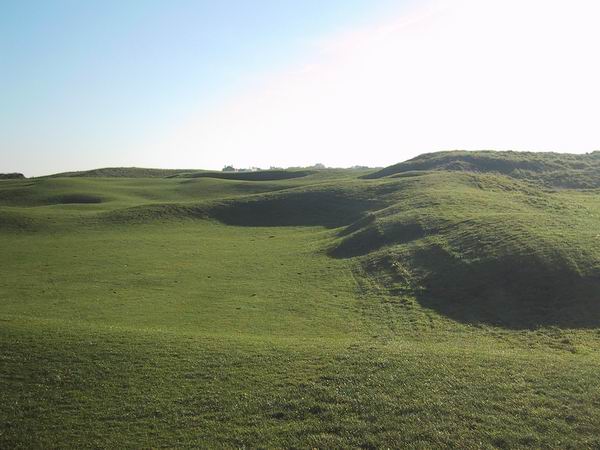
In medieval England, the defense for the counties of Kent and East Sussex, fell to a confederation of the five main ports at that time. These were, Dover, Hythe, Hastings, Romney and Sandwich, plus two other towns, Rye and Winchelsea. Their correct title is, The Cinque (pronounced ‘sink’) Ports and two ancient towns. The sailors who worked in these towns were basically given carte blanche to pillage and plunder at will. Many enjoyed this right as ‘tribute’ for defending the crown.
Thankfully, the town of Deal (conveniently situated close to Sandwich) maintains a more stately presence in the 21st century and a lovely golf course to play. Royal Cinque Ports or Deal as it is affectionately known lies south of its bigger brother at Sandwich (Royal St. Georges). Along with Princes, these three clubs form a holy triumvirate of links golf on the Kent coast. While Deal is not a hidden little gem by any account, it is in my estimation undervalued and overlooked as a great links course. Simply put, the game at Royal Cinque Ports (Deal) is superb.
Deal’s history contains many past glories. It has hosted two Open Championships (1909 and 1920) including the infamous one where Walter Hagen was forced to put his shoes on outside the clubhouse and a British Amateur. If not for the war years and flooding from the English Channel, it would have boasted more championships. Still, the clubhouse at Royal Cinque Ports sits on a noble perch with a flagpole donated by the Marines in front.
One begins a round at Deal by gazing in two directions. Due east, you see the seawall which protects the course from flooding. Straight ahead lies a simple 360-yard opening hole. My view of the green was somewhat hindered by the fog that plagued my round. It was a beautiful sunny day inland and quite warm but a low lying cloud lingered over the course and made taking good camera shots impossible.
The 1st Hole at Deal resembles the 1st at St. Andrews. It is a drive and pitch hole with a burn running right in front of the green. Two bridges cross the burn with the right bridge being the line for the tee shot. There is plenty of green to work with at the 1st and it is a fine introduction for a match. As you walk down the fairway you notice one difference about Deal than Sandwich. It is less remote. Golf Road with some sporadic traffic flanks the right side and there is a feeling of bustle you don’t experience at the first tee at Sandwich. This does not matter though as you graduate to the 2nd tee.
Ah, here is when Deal starts. The 2nd turns in the opposite direction to the first and is a sample of the wonders to follow. The fairway on this 399-yard par 4 has humps, bumps, hillocks, depressions, pimples and valleys. Everything but the kitchen sink. It is here that we learn that straight and long driving is a key asset to play at Deal. The prevailing south wind is with us now as it will be for the next five holes. Key on this hole is your approach with the uneven lies in the fairway. Stopping a wedge downwind on Deal’s very fast greens deems itself a worthy antagonist.
The 3rd at Deal is a short par 5 at 508 yards but dear in my heart. A fairway bunker looms 250 yards out on the left side and two bunkers right will capture any mishit lay-up. The joy on this hole lies in the green complex. There is no site of the flag until you climb to the top of the hill 150 yards from the fairway. What you do not see and what makes for a tricky 3rd shot pitch (that is if you have not gone for it in two) is a lovely punchbowl green. With a front pin placement and a helping wind, getting close requires unique precision or luck. The front of the green is a few feet sunken below fairway depth and there is a second tier or spine to deal with in the middle. Expect a sharply breaking putt. I did and wound up with a birdie and a smile.

The beauty of Deal is evident in this view across the 4th tee and 3rd green.
Deal’s fourth hole is the first par 3. Its name is Sandy Parlour and you attack the hole from an elevated tee. Selecting the right weapon in your hand on this short hole (148 yards) is paramount as the downwind approach makes for a dicey little shot. The green complex is also wider than it is deep and this confounds any error in shot making.
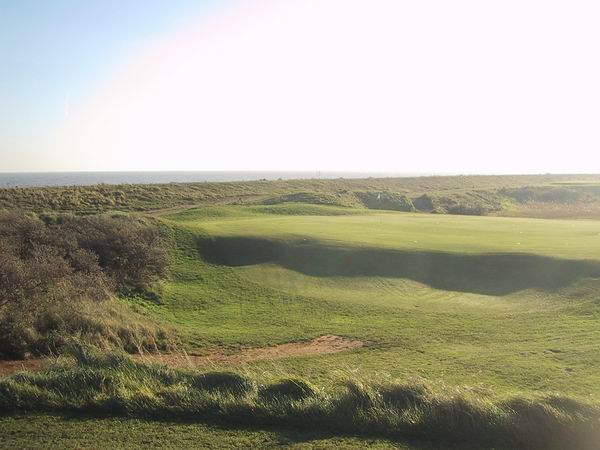
A tricky recovery shot is left for any who miss the 4th green.
It was at the 6th hole that I started to really fall in love with Deal’s charms. Donald Steel describes the hole as a quaint little drive and pitch to an elevated green. A large sand hill obscures the hole as it doglegs to the right. A long power fade over the hill with the helping wind might allow you to drive the green. It also might find you with a delicate chip from the gully fronting the hole. Up and down from that gully was on my mind as my ball skirted the chasm and landed pin high before releasing to the back of the green. In the days before the seawall, the Channel beach would have been right behind the green.
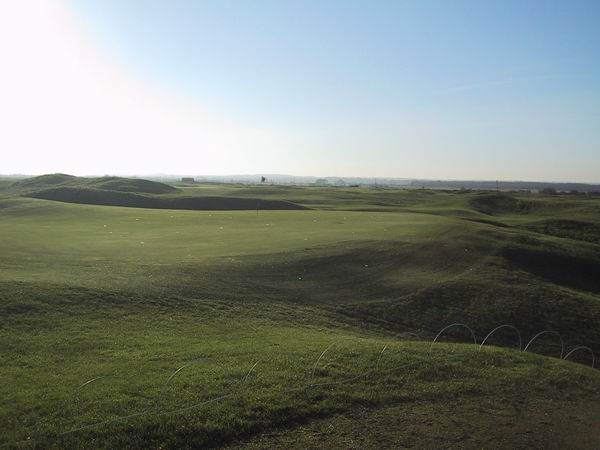
The crowned 6th green does little to help hold the ball on the green.
The 8th hole changes direction from north to east, as this is a testing par 3 of 165 yards surrounded by nine pot bunkers. A fade that holds its line into the south wind may get you close to glory and the flag.
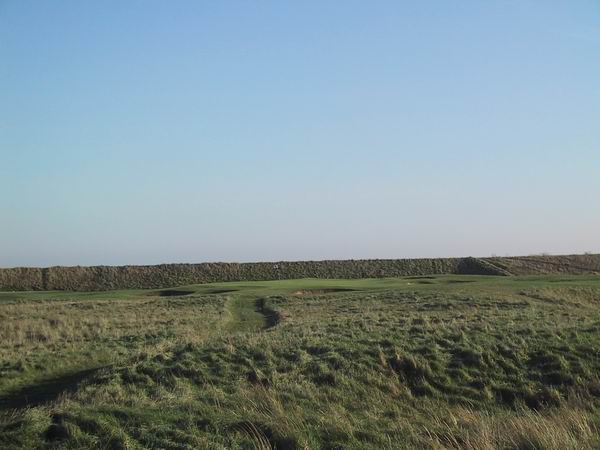
The isolated 8th green is surrounded by pot bunkers.
After finishing the 9th, which turns back north, a small halfway house beckons and one must take a sojourn here before descending into hell. A hellacious and incredibly challenging back 9 awaits. It all gets off innocently enough with the 10th and the 11th which both dogleg to the left. A wonderful view towards Sandwich can be seen from the tee on #11 and if the wind is coming off the Channel a bunker 230 yards out on the left will be a challenge to avoid. My friend Jim Reilly sees a lot of Shinnecock Hills in the look of this hole. As we putt out on #11, the hair on my neck started to rise. The course now turns back south, into the teeth of the prevailing wind. Hopefully the golfer has the ability to hit piercing and boring 230 yard fairway woods because the next six holes demand their ‘tribute’ just like the sailors of that begotten Cinque Ports era.
The 12th hole is a long 441-yard brute where the wind leaves any drive with at least 200 yards to go. A boring draw to the left side of the fairway is what the wind demands. Any short approach to the hole will find a nasty bunker fronting the left side of the green but the green is somewhat receptive.
At the 421-yard par 3 13th, two bunkers stand out as watchdogs as the correct line is over the left bunker. While it only takes 200 yards to carry these bunkers, the wind makes them seem in play. Cross bunkers play as visual reminder 100 yards short of the green but the real danger is the cluster of bunkers waiting to find any hooked or pulled approach shot. The green on this hole has a good deal of undulation running thru it and a three putt is a likely outcome.
The 15th at Deal is just plain hard. 450 yards into the south wind seems like a vast ocean to cross. Again, two bunkers stand sentry on the right side of the hole 240 yards away. The best line is a draw that flirts with the left fringe of this bunker but ends up left center of the fairway. The approach doglegs to the right and is blind to a tall marker post behind a green that totters on the crest of a ridge. There are huge heaving mounds in front of the green that extend out 150 yards back down the fairway. As the hole is so long, you invariable find yourself pitching from these mounds with an uneven lie back to the hole.
When we finally arrive to the 16th at Deal, we might as well be in links golf nirvana. For my money it is the best par 4 links hole I have played. Henry Cotton had it as one of the top 18 best holes in England and others have referred to it as, ‘the greatest hole in golf.’ Bernard Darwin deemed it too hard for a two shot hole into the wind but also said the second shot is an inspired one. Well, the club used to have this hole as a par 4, but at its full length it now plays at 505 yards and a par 5. From the tee, you can see the flag sitting upon a small shelf of a sand dune in the distance. It stands there as a defiant reminder of the battle you are about to commence. Another cross-bunker awaits 220 yards out. Next to the cross bunker and reminiscent of the 4th at Rye is a World War II pillbox. After arriving at your tee shot and most likely having near 300 yards still to go you are left with an inspiring 2nd shot. One can hit all of they can and risk landing short where two bunkers are hidden by the huge heaving fairway. In fact, the whole fairway seems to look like a hungry ocean complete with swells, crests and hollows. It is walking thru this amazing landscape that you again realize the delights of Deal. If you find a decent lie for your third or land in the valley fronting the green, a surgical pitch is required to hit the small, elevated green. Like most of the other greens there remains a good amount of contour to have to gauge your putts here.
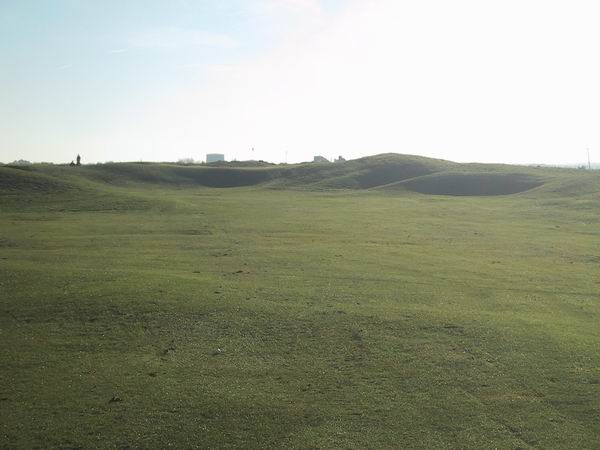
The difficult approach to the 16th green, with the flag visible on the shelf in the distance.
The penultimate hole is a great one in match or medal play. Bernard Darwin referred to the approach as one of the luckiest holes in golf. A drive down the right side will land you in, ‘Vardon’s Parlour’ where Harry Vardon landed all his drives in the 1909 Open Championship. From the right side you can see the flag, if you have driven left your view is disturbed by contortioned sand dunes. Two cross-bunkers 60 yards short of the green also play visual havoc with the approach.
Finally, we get to the 18th. An orthodox, 407 yard par 4 again over the burn and back to the clubhouse. Like the first you aim out at the right bridge and hopefully leave a 6 iron or so to a slightly elevated but mainly flat green. When you finish, head into the clubhouse bar for a pint to ease the pain from the last few holes’ score.
When I finished my round, my playing partner and I were fortunate enough to meet the club secretary, Mr. Colin Hammond. Mr. Hammond was a delightful gentleman who took the time to talk about the club’s history and show us pictures of the course under various flooding conditions. We also talked about the threat to Sandwich from flooding and some of the propositions for a new sea wall, which will affect Deal’s neighbors and their courses. Mr. Hammond also expressed his hope to have a Walker Cup at the club in the future and about the current issues they faced with drainage and bunker re-vetting.
As we drove away from Deal I thought of two things. Darwin said the golf at Deal was, ‘very good indeed-fine straight ahead hitting golf, where the fives are likely to be many and the fours few.’ As I tallied my score card, he was right on the mark. I went out in 39 and home in 46 or as Mr. Hammond said, is a common score at Deal also referred to as a ‘World War II’ round. The second thing I thought about was how Tom Doak only gave the course a 6 on his ratings scale. In my mind, it was worthy of an 8 with extra points for being a sporty and extremely fun place to play.
As we drove back to London from Deal and passed the white cliffs of Dover, the end of Matthew Arnold’s poem Dover Beach came to mind.
And we are here as on a darkling plain
Swept with confused alarms of struggle and flight,
Where ignorant armies clash by night.
Arnold was speaking of the disenchantment, the confusion we can all feel in life. After playing Deal I felt the opposite. I felt a divine feeling of full contentment.
The End

